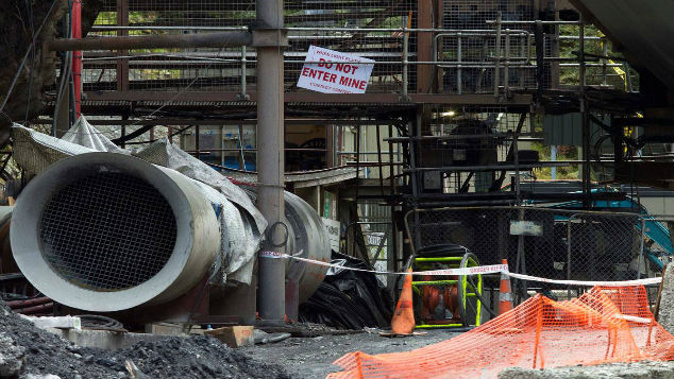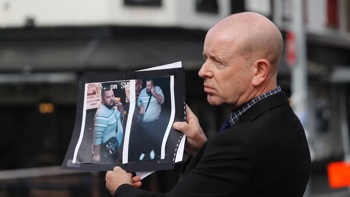
Miners are nearing the collapsed roof at the end of Pike River mine's main access tunnel, as the country marks 10 years on from New Zealand's worst mining disaster in almost 100 years.
On November 19, 2010, an explosion at the mine was reported about 3.44pm. Only two people walked out of the mine that day – 29 people were unaccounted for.
Five days later a second explosion occurred about 2.37pm, and the police stated they believed no one could have survived.
It was the worst mining disaster since the death of 43 miners in the Ralph Mine explosion in 1914.
/cloudfront-ap-southeast-2.images.arcpublishing.com/nzme/YSOTHMVG5YIP4CE44VE2NVXFHY.jpg) The entrance to Pike River mine. The main access tunnel extends for 2.3km. Photo / PRRA
The entrance to Pike River mine. The main access tunnel extends for 2.3km. Photo / PRRAThe Pike River Recovery Agency's chief operating officer, Dinghy Pattinson, is leading the work underground.
He said miners were, as of Monday, 2146m inside the main mine tunnel, and less than 100m away from the Rocsil plug, 10.3m of expanding foam that was pumped down a borehole in late 2019.
It expanded to 35 times its original size to fill the entire width and height of the tunnel.
The plug kept oxygen out of the areas beyond – the last eight metres of the drift (the main mine tunnel), roof fall (an area of tunnel that collapsed in following the explosion), and the mine workings (4.3km of tunnels where the coal was extracted – and where the remains of the 29 miners are expected to be).
Pattinson said the lack of oxygen meant the miners would have to wear breathing apparatus as they tunnelled through the plug.
/cloudfront-ap-southeast-2.images.arcpublishing.com/nzme/4YK3CIS4BXVHBS33DE4SY4R7KI.jpg) Miners are nearing the end of the Pike River mine access tunnel - the Rocsil plug is one of the last remaining barriers. Photo / PRRA
Miners are nearing the end of the Pike River mine access tunnel - the Rocsil plug is one of the last remaining barriers. Photo / PRRA"You can get four hours out of that breathing set, when we do that work, we want less than 2 per cent oxygen in the tunnel so we have to wear to breathing apparatus," he said.
To practice operating with no oxygen, a shipping container had been pumped full with the same foam on the surface, with miners "tunnelling" through it wearing the breathing apparatus.
After building a concrete wall with an airlock to replace the plug, Pattinson expects to have tunnelled through the plug and reached the roof fall by Christmas.
"We will have to do the full forensic examination on behalf of the police ... it will be treated just like the rest of the tunnel, the only difference is we will be doing it in breathing apparatus," he said.
Then miners will then return to Pit, Bottom in Stone – a 600m network of tunnels off both sides of the main tunnel, which had previously been "roped off" as a potential crime scene.
That area contained electrical and water equipment – all potential clues that could shed light on what happened underground 10 years ago leading to the explosion.
"It's 10 years since the disaster and there are still 29 men in the mine itself and far beyond 29 families who hurt to this day, and people have not been held to account and certainly it is common acceptance the mine, in some aspects, was not well run – particularly around health and safety," said Pike River Recovery Agency chief executive Dave Gawn.
Accountability is something families of those who died had been calling for for years. About $110,000 was offered to each family by former Pike River Coal chief executive Peter Whittall and the company's directors after 12 health and safety charges against Whittall were dropped in 2013.
"Every worker must have the right to come home safely at night," said Gawn.
"Along with that is an element of justice – and holding people to account when required."
"If the evidence is able to meet the threshold for the legal case then, absolutely, people should be held to account in the courts."
Pattinson agreed.
"Hopefully somebody will be held to account because 29 people died that day."
The Herald attempted to contact Peter Whittall, who now runs Illawarra Diggers – a rest home in Wollongong, New South Wales.
There has been no response.
Back at the mine site, despite about three months of delays due to Covid-19 as well as other unforeseen factors, including the discovery of carcinogens in August 2020 that briefly halted work, the end was in sight.
/cloudfront-ap-southeast-2.images.arcpublishing.com/nzme/4IBNBOSSQZE2T3V66OP3PJ32ZM.jpg) Miners practice tunneling through a shipping container filled with the same foam as the Rocsil plug. They have to wear breathing equipment as there will be little to no oxygen. Photo / PRRA
Miners practice tunneling through a shipping container filled with the same foam as the Rocsil plug. They have to wear breathing equipment as there will be little to no oxygen. Photo / PRRAMiners and police would work to forensically examine Pit Bottom in Stone, before withdrawing from the mine completely and handing the site over to the Department of Conservation.
Gawn said the agency would be "downsizing" in the New Year, with the current two shifts – day and night – being cut down to one.
He said he had not been involved in any discussion about extending the agency's mandate to only recover the drift – the mine workings at this stage would not be searched, which some families had been called for.
On the 10-year anniversary of the disaster, more than 100 relatives and friends of those who died are expected to gather on the West Coast.
They will first visit the Atarau memorial, just down the road from the mine itself.
They will then travel to the mine portal where, at 3.44pm, they will stand in silence for one minute before listening to a rollcall of the 29 men. A memorial service will be held at Blackball later in the afternoon.
A service will also be held in Wellington, which Prime Minister Jacinda Ardern, Pike River Recovery Minister Andrew Little and other dignitaries are expected to attend.
Timeline of events
March 2004: Approval given for Pike River Coal to open an underground mine.
October 2008: The mine formerly opens.
February 2010: After a number of delays, the first shipment of coal from Pike River is exported.
19 November 2010: A methane gas explosion occurs deep inside the mine – two workers walked out but 29 remained missing.
24 November 2010: A second explosion occurs – Pike River Coal chief executive said there was no chance the workers were still alive.
26 November 2010: A third explosion rocks the mine.
28 November 2010: The mine is sealed after a fourth explosion.
29 November 2010: The government announced a Royal Commission of Inquiry into the disaster.
13 December 2010: Pike Rover Coal goes into receivership.
14 January 2010: The police abandoned attempts to recover the 29 bodies.
5 November 2012: The Royal Commission recommends changes to health and safety laws, finding the miners were exposed to "unacceptable risk".
15 August 2017: Prior to the 2017 election the Labour party, Green party, Māori party, and United Future signed a cross-party agreement to renter the mine.
31 January 2018: The Pike River Recovery Agency established.
14 November 2018: Minister Andrew Little approves single re-entry of the mine.
21 May 2019: 30m barrier breached and the mine was re-entered.
Take your Radio, Podcasts and Music with you









